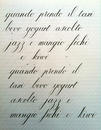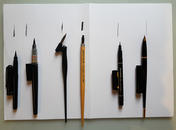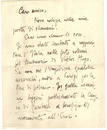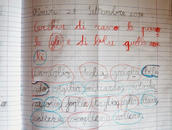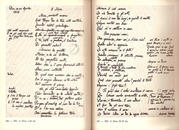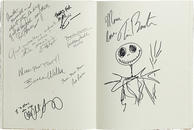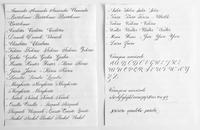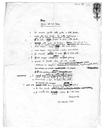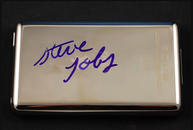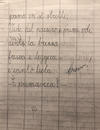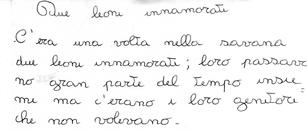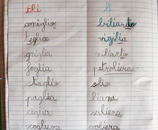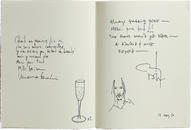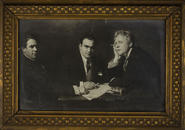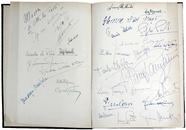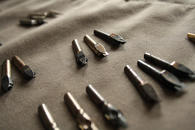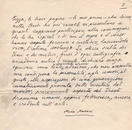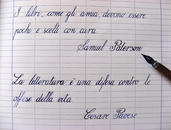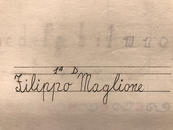To relearn
Over the last few months, I have been asked to put a long series of “legible signatures” on all sorts of official documents - not my classic signature, a succinct scribble that I have used for the past thirty years. I was forced to write with the precise aim of it being intelligible, going beyond not only my signature, but also the lazy and extemporaneous handwriting that I normally use for my personal notes on scattered sheets (notes that I elaborate further when typing them in front of a bright monitor).
By trying to form letters in a forced and unnatural way, I discovered that I no longer know how to write. I figured this was the case, the result of a decade of lack of practice, but there, in the moment, I felt ashamed. The world I was born into, because it was really another world, took calligraphy very seriously – it was almost considered a school subject like grammar, by far the most important subject of all. During the early years of my schooling, all the important tests, the sacred tests upon which our final grades depended, were based on a dictation and a writen summary. First came the dictation. We had to transcribe a text that the teacher recited with melodramatic emphasis (capital letters fail to express all the power with which the majestic, authoritarian, old and indisputable woman used when reciting the dictation to us). The dictations were corrected with energetic and sometimes violent red pencil marks, accompanied by a written comment that ranged from “Dunce” to a very rare “Bravo!” when there were no mistake and beautiful hand-writing. If the dictation was error-free but not beautiful, meaning legible but not refined, it was given a “good.” At the beginning, I received many “goods,” but I improved my hand-writing, with ease and satisfaction, and finally received to the level of “Bravo!”
Looking back, I feel that the “ease and satisfaction” are what led me to become a graphic designer - that it's not just a job (labor: fatigue) but above all a profession (magisterium) and a lifestyle. For the sake of paradox, a considerable part of my professional activity has involved, and involves calligraphy, meaning that I am responsible for the harmonious arrangement of letters and words, even if by invasive means such as the computer. Therefore, discovering this shortcoming of mine spurred a sense of guilt that led me to enroll in a continued education course to try to re-learn how to write (making my sister Tiziana, a prominent graphologist, quite pleased).
As a devoted reader of the Sunday edition of the Italian newspaper, Il Sole 24 Ore, I went back to re-read an article by Roberto Casati that I had enjoyed, but not dedicated the proper attention to the first time around. I had read it a couple months ago and it took me a while to find. (My collection of old newspapers is getting out of control and has taken over both book shelves and drawers.) Casati, with his usual fervor, began by citing Steve Jobs's stunning and famous lesson at Stanford University in 2005, using it as a springboard to question the media’s focus over the past years: startups, innovation, internet and business, as well as questioning the values of hard work, the pursuit of stellar teachers, business culture at the university level ... in short everything that would be reasonably included in a methodological-deterministic approach to specific goal with a precise trajectory. It challenges our obsession with “planning” because during Job’s speech, which has become the very emblem of the approach to success through intelligence, he essentially says three things:
1) That having taken a totally useless calligraphy course allowed him, ten years later, to design a certain type of computer that changed the way everyone worked: the graphical interface of a Mac computer is based on an obsession for the elegance of writing and typography. 2) Having been fired by the company that he founded proved to be the best thing that ever happened to him. 3) The best way to be creative is to remember, day after day, that you are mortal.
Rightly so, Casati points out that the last point refers to a somewhat mystical personal story linked to the illness that Jobs battled towards the end of his life, while the second is a very special and perhaps unrepeatable case of corporate parable. Therefore, Casati focuses on the first, more universal point, so that we can seriously think about “training,” not just scholastic or university, in an increasingly fluid, complex and random world without real reference points or support.
Jobs explains that real understanding only comes at the end of the journey, but at the beginning, one must be confident in the fact that somehow a guiding thread will be found (without this trust you won’t get anywhere).
He says we must believe it, even if we don’t know future holds. Without having the slightest idea of what tomorrow will bring, we should be passionate about do something beautiful and difficult and apparently useless, such as the intricate visual complexity of the written word and the typographical character; then we will see.
Therefore, from this beautiful and eccentric perspective of Steve Jobs, my backward journey may seem a bit bizzare, forced to undertake, for a second time, the initiation ritual of an art that was decisive for my professional training, re-threading the thread of trust in the contrary: a trust, this time, focused on the past.
06/06/2017 Filippo Maglione



